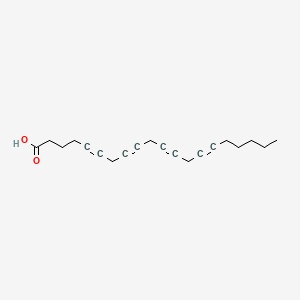| O'Flaherty JT et al. |
Role of arachidonic acid derivatives in neutrophil aggregation: a hypothesis. |
1979 |
Prostaglandins |
pmid:504694
|
| Bokoch GM and Reed PW |
Inhibition of the neutrophil oxidative response to a chemotactic peptide by inhibitors of arachidonic acid oxygenation. |
1979 |
Biochem. Biophys. Res. Commun. |
pmid:508315
|
| Hand JM and Buckner CK |
Effects of selected antagonists on ovalbumin-induced contraction of tracheal strips isolated from the actively sensitized guinea-pig. |
1979 |
Int. J. Immunopharmacol. |
pmid:551965
|
| Jorgensen HP and Sondergaard J |
Biosynthesis of prostaglandins by human inflamed skin. |
1976 |
Acta Derm. Venereol. |
pmid:56850
|
| Schnermann J et al. |
The effect of inhibition of prostaglandin synthesis on tubuloglomerular feedback in the rat kidney. |
1979 |
Pflugers Arch. |
pmid:572538
|
| Snider RM et al. |
Activation of cyclic nucleotide formation in murine neuroblastoma N1E-115 cells by modified human thrombins. |
1984 |
J. Biol. Chem. |
pmid:6086621
|
| Fantini F |
[Recent discoveries in the field of mediators of anti-inflammation: leukotrienes]. |
1984 |
Clin Ter |
pmid:6088163
|
| Marom Z et al. |
Prostaglandin-generating factor of anaphylaxis induces mucous glycoprotein release and the formation of lipoxygenase products of arachidonate from human airways. |
1984 |
Prostaglandins |
pmid:6091187
|
| Vlaskovska M and Knepel W |
Beta-endorphin and adrenocorticotropin release from rat adenohypophysis in vitro: evidence for local modulation by arachidonic acid metabolites of the cyclooxygenase and lipoxygenase pathway. |
1984 |
Neuroendocrinology |
pmid:6092988
|
| Ziboh VA et al. |
Biosynthesis of lipoxygenase products by enzyme preparations from normal and psoriatic skin. |
1984 |
J. Invest. Dermatol. |
pmid:6094672
|
| Falkenhein SF et al. |
Effect of the 5-hydroperoxide of eicosatetraenoic acid and inhibitors of the lipoxygenase pathway on the formation of slow reacting substance by rat basophilic leukemia cells; direct evidence that slow reacting substance is a product of the lipoxygenase pathway. |
1980 |
J. Immunol. |
pmid:6103910
|
| Watanabe-Kohno S and Parker CW |
Role of arachidonic acid in the biosynthesis of slow reacting substance of anaphylaxis (SRS-A) from sensitized guinea pig lung fragments: evidence that SRS-A is very similar or identical structurally to nonimmunologically induced forms of SRS. |
1980 |
J. Immunol. |
pmid:6104681
|
| Regal JF |
C5a-induced aortic contraction: effect of an antihistamine and inhibitors of arachidonate metabolism. |
1982 |
J. Pharmacol. Exp. Ther. |
pmid:6118427
|
| Mencia-Huerta JM et al. |
Release of a slow-reacting substance from rabbit platelets. |
1981 |
J. Clin. Invest. |
pmid:6119324
|
| Clarke BA and Clarke SD |
Suppression of rat liver fatty acid synthesis by eicosa-5,8,11,14-tetraynoic acid without a reduction in lipogenic enzymes. |
1982 |
J. Nutr. |
pmid:6123562
|
| White AA et al. |
Role of lipoxygenase in the O2-dependent activation of soluble guanylate cyclase from rat lung. |
1982 |
Biochem. J. |
pmid:6126185
|
| Capdevila J et al. |
Novel hypothalamic arachidonate products stimulate somatostatin release from the median eminence. |
1983 |
Endocrinology |
pmid:6134613
|
| Songsiridej V et al. |
Pharmacological alteration of antigen-induced contraction of lung parenchymal strips isolated from the actively sensitized guinea pig. |
1983 |
Eur. J. Pharmacol. |
pmid:6138261
|
| Wikland M and Lindblom B |
The role of prostaglandins in the stimulatory action of catecholamines on myometrial activity in term pregnant women. |
1983 |
Eur. J. Obstet. Gynecol. Reprod. Biol. |
pmid:6141078
|
| Snider RM and Richelson E |
Bradykinin receptor-mediated cyclic GMP formation in a nerve cell population (murine neuroblastoma clone N1E-115). |
1984 |
J. Neurochem. |
pmid:6149270
|
